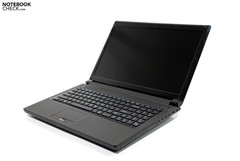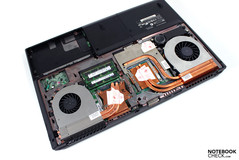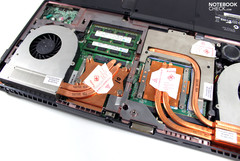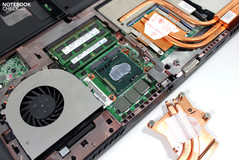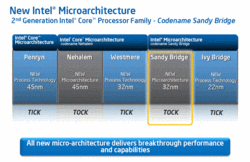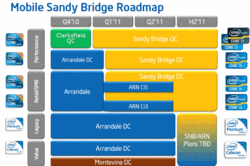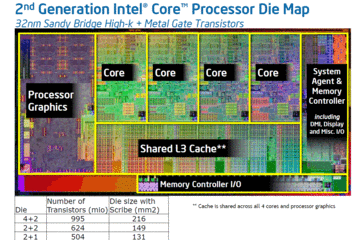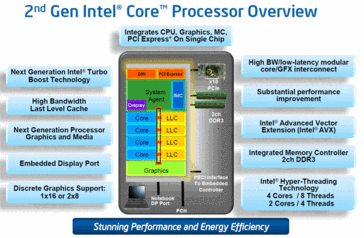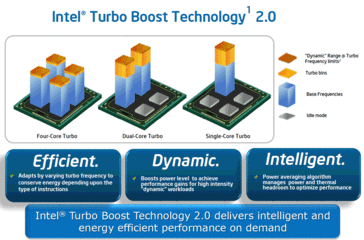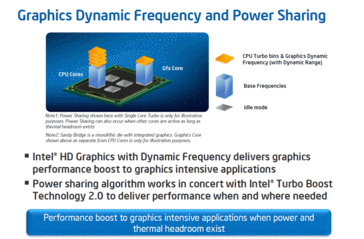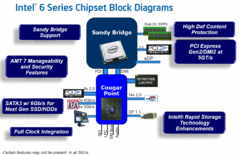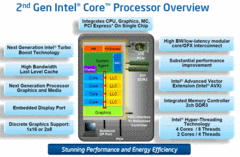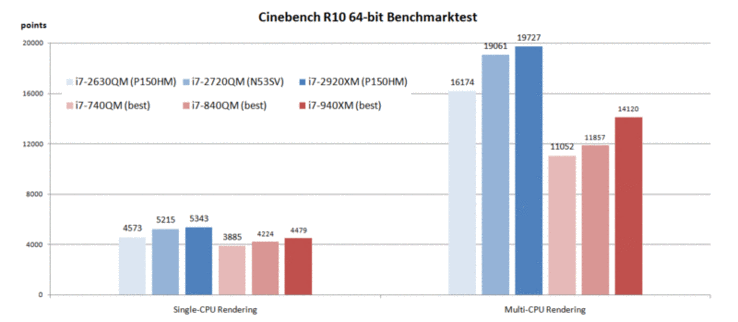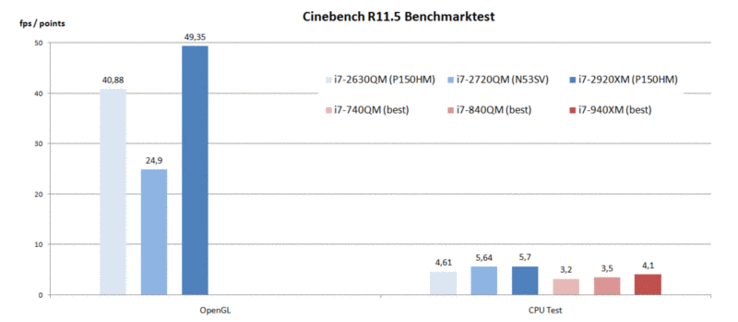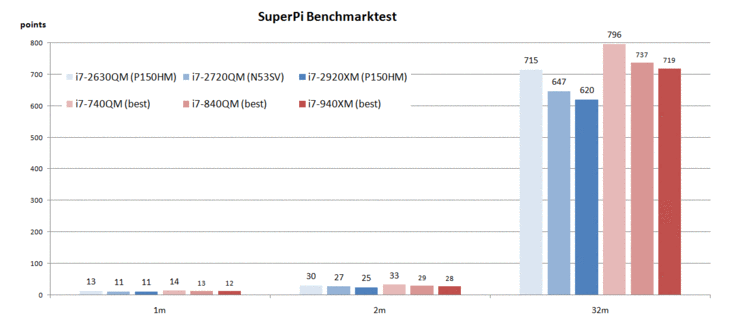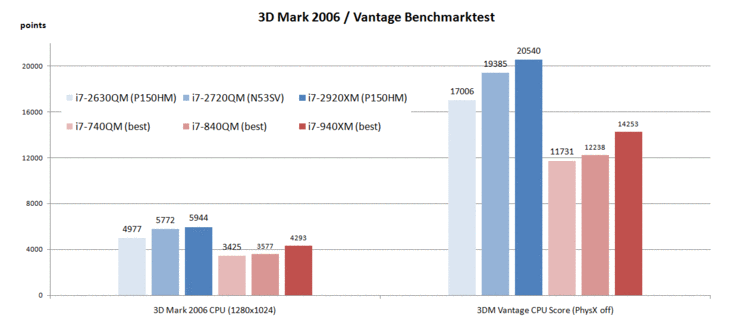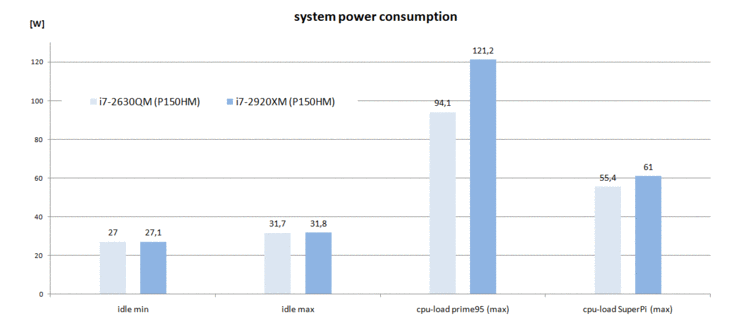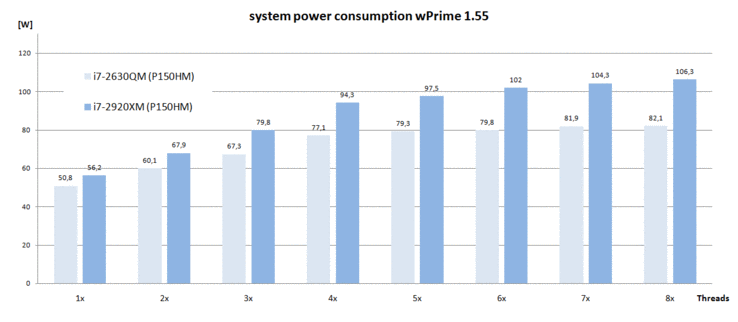Review Intel Sandy Bridge Quad-Core processors
New year, new CPUs from Intel. This has already nearly become a tradition. Referred to as Tick-Tock Model Intel delivers an entirely new processor microarchitecture (Tock) about half a year after a new silicon process technology, increasing transistor density (Tick). Such innovations are usually attended by some new features and a corresponding performance gain compared to the predecessors.
In this test we provide a first overview of the performance reserves to be expected. For now, we just deal with some quad core models. As soon as they are available, we will add all the other quad-core chips and review the dual-core Sandy Bridge processors in detail.
The Test System
We used a Clevo (P150HM) for our CPU tests. Called XMG P501 this notebook is for example offered by Schenker-Notebooks. The small 15-incher can be equipped with the new Sandy Bridge quad core chips up to the i7-2920XM CPU. Its Nvidia GTX 485M graphics card delivers top performance in games. A detailed review of this notebook including comprehensive gaming analysis of the Geforce GTX 485M GPU, the currently most powerful mobile single core graphics processor, will be available on notebookcheck.net within the next few days.
Test Configuration:
- Windows 7 Home Premium 64bit
- Intel ID0104 chipset
- Intel Core i7 Quadcore Sandy Bridge CPUs
- Nvidia Geforce GTX 485M 2GB GDDR5 VRAM
- 15.6“ Full-HD LED Display, Non-Glare!
- 16GB DDR3 RAM 1333MHz
- Seagate Momentus ST9750420AS HDD (750GB/7200rpm)
- Price: not yet fixed, depends on the configuration
Intel Core Mobile Processor Lineup "Sandy Bridge"
After the "Clarksfield-Refresh" in autumn last year, which just slightly improved the clock rates of the quad core CPUs, the Sandy Bridge architecture delivers an entirely new microarchitecture. On top of that Intels Roadmap already depicts the next step in CPU evolution: Ivy Bridge. Once again decreasing transistor size and implementing the microarchitecture on 22 nanometer process technology are the cornerstone. Thereby, the die can house more transistors and a performance gain is to be expected.
According to Intel, the fate of today's Clarksfield processors is already sealed. From now on, they shall be replaced by the new Sandy Bridge quad cores. In order to promote the replacement, Intel control the prices accordingly. The successors of the 740QM, 840QM, and 940XM processors cost virtually the same (according to insiders marginally more in the beginning). Considering the performance gain of the new processors manufacturers might find this offer tempting.
The successors of the Arrandale dual core processors are going to be launched in the first weeks of 2011 and also completely replace the existing lineup. In the Value/Legacy and Retail/SMB segment today's Arrandale CPU should be continued during about the first half of 2011.
| Name | Cores | Base Clock | max. Turbo | L3-Cache | TDP | GFX-clock | Price (Intel, 1k units) |
|---|---|---|---|---|---|---|---|
| Quadcore | |||||||
| Core i7-2920XM | 4/8 | 2.5 Ghz | 3.5 Ghz | 8MB | 55W | 650-1300MHz | $1096 |
| Core i7-2820QM | 4/8 | 2.3 Ghz | 3.4 Ghz | 8MB | 45W | 650-1300MHz | $568 |
| Core i7-2720QM | 4/8 | 2.2 Ghz | 3.3 Ghz | 6MB | 45W | 650-1300MHz | $378 |
| Core i7-2635QM | 4/8 | 2.0 Ghz | 2.9 Ghz | 6MB | 45W | 650-1200MHz | - |
| Core i7-2630QM | 4/8 | 2.0 Ghz | 2.9 Ghz | 6MB | 45W | 650-1100MHz | - |
| Dualcore | |||||||
| Core i7-2620M | 2/4 | 2.7 Ghz | 3.4 Ghz | 4MB | 35W | 650-1300MHz | $346 |
| Core i5-2540M | 2/4 | 2.6 Ghz | 3.3 Ghz | 3MB | 35W | 650-1300MHz | $266 |
| Core i5-2520M | 2/4 | 2.5 Ghz | 3.2 Ghz | 3MB | 35W | 650-1300MHz | $225 |
| Core i5-2410M | 2/4 | 2.3 Ghz | 2.9 Ghz | 3MB | 35W | 650-1200MHz | - |
| Core i3-2310M | 2/4 | 2.1 Ghz | - | 3MB | 35W | 650-1100MHz | - |
| Dualcore LV/ULV | |||||||
| Core i7-2649M | 2/4 | 2.3 Ghz | 3.2 GHz | 4MB | 25W | 500-1100MHz | $349 |
| Core i7-2629M | 2/4 | 2.1 Ghz | 3.0 GHz | 4MB | 25W | 500-1100MHz | $311 |
| Core i7-2657M | 2/4 | 1.6 Ghz | 2.7 GHz | 4MB | 17W | 350-1000MHz | $317 |
| Core i7-2617M | 2/4 | 1.5 Ghz | 2.6 GHz | 4MB | 17W | 350-950MHz | $289 |
| Core i5-2537M | 2/4 | 1.4 Ghz | 2.3 GHz | 3MB | 17W | 350-900MHz | $250 |
What's inside the new chips? From a systematic point of view, the quad core CPUs house four discrete cores, a graphics unit, called Intel HD Graphics 3000, a shared L3-Cache, called Last Level Cache –"LLC" now, the memory-, PCIExpress-, and the display controller. From now on, the quad-corers are implemented on 32 nanometer process technology. This is also true for the graphics processor incorporated in the architecture, which was implemented on 45nm and visibly placed on the package beside the CPU in the previous Arrandale processors.
Alike in the Arrandale and the Clarksfield processors the Intel Turbo Boost technology is a key features. It allows a dynamic adjustment of the cores' maximum clock frequencies to the specific load at a time. So, both, applications that require high clock frequencies in single cores and those profiting from many parallel cores can be optimally supported.
We are already familiar with the general concept from the former Intel Core processors. However, the "Dynamic Range @ Turbo Turbo Frequency Limits" are new in Turbo Boost 2.0. It is a range above the fixed maximum clock rates of the standard Turbo Boost, which can be used upon additional reserves of the cooling system in a smart way, e.g., when the cores just start getting warmer. So, after a time without load or at sufficient cooling reserves the CPU can overclock very high for a short time. Furthermore, the Turbo control was significantly improved. As a consequence the processor can be in higher turbo levels for a longer time.
While the RAM is directly attached to the CPU, up to eight PCIExpress 2.0 interfaces, 14 USB 2.0 ports, Displayport 1.1, SATA3 (6GB/s) and the Ethernet chip are connected to the CPU via the "Cougar Point" chipsets. The up-to-date USB 3.0 is not available, but, according to rumors it should first be integrated in Ivy Bridge.
In addition, the user might find a number of features Intel packed into their new platform interesting. These include among others Intel Quick Sync Video, which should accelerate decoding and encoding of videos, Intel InTru 3D allows the connection of a 3D-capable display (stereoscopic) via HDMI 1.4 for 3D Blu-Ray rendering, Intel Clear Video HD, Intel Wireless Display, which enables the wireless transmission of 1080p data to an external screen, and the built-in Intel HD Graphics 3000 or HD 2000 graphics solution, which brings about a performance gain in games and, furthermore, reserve capacities for professional picture and video editing.
In the fast quad core CPUS the graphics chip uses a dynamic clock from 650 to 1300MHz. In addition, it supports DirectX 10.1, OpenGL 3.0, and Shader Model 3.0. Maximum resolution displayed: 2560x1600 pixel. Details regarding the performance of the new integrated Intel HD Graphics 3000 graphics solution are available in our special review.
Synthetic Benchmarks
Cinebench R10
The Rendering tests of Cinebench R10 is still important, because they evaluate both, the performance of a single core/thread and of all available cores together. The more points achieved, the higher the performance reserves of the chip. We used the 64-Bit version of the benchmark tests, which usually displays higher scores than the 32-bit version. However, this cannot be interpreted as a performance gain.
We compare the results of our P150HM test platform and of the Asus N53SV (2720QM) to the best results of Clarksfield processors in our database.
The conclusion seems unambiguous: Even the i7-2630QM CPU, the new entry-level solution into the world of mobile quad cores, ranks yet in front of the Intel i7-940XM Extreme CPU in both tests (Single-Core and Multicore Rendering Test).
Directly comparing the i7-740QM and the i7-2720QM, the Sandy Bridge CPU is about 34% faster in Single-Core Rendering. In the Multi-Core Test the two processors differ by 72%. The difference between the two Extreme models, 940XM and 2920XM is similar if they are not overclocked. In the Cinebench R10 Single-Core Rendering Test the Sandy Bridge CPU achieves 5343 points or plus 19%, in the Multi-Core Test it outperforms the Clarksfield-CPU by 36%.
Cinebench R11.5
The current Cinebench R11.5 test does no longer distinguish between single cores and evaluates the performance of all available threads in the standard test. Here too, the i7-2630QM CPU is better than the best result for the 940XM-CPU in the CPU-Test. Comparing 740QM and 2720QM, the Sandy Bridge CPU marks a prominent performance gain of 76%. In the Extreme league the 2920XM is 39% faster than its predecessor.
Comparing the results of the OpenGL test of the Asus N53SV (GT 540M) to the XMG P501 (GTX 485) reveals a significant impact of the graphics card. However, the potential performance gain within the CPU lineup is also of interest. Our P510 test system with i7-2630QM CPU achieves for example 40.88 fps in this test. But, the same platform configured with a i7-2920XM CPU can even accomplish 49.35 fps. That is a plus of about 21% just due to the faster CPU.
Super Pi
The SuperPi benchmark is especially popular with overclockers. It calculates the number PI to a pre-defined precision and records the time needed. The lower the result, the faster and stronger the built-in CPU. SuperPi only uses a single core, so a high clock frequency is the decisive factor.
Calculating 32 million decimal places, the results conform to the former tests: Already the i7-2630QM CPU proves to be faster than the former high-end solution, the i7-940XM. In comparison the 2720QM CPU is about 23% faster than its predecessor, the i7-2920XM delivers a performance gain of about 16%.
3DMark 2006 / Vantage
The current versions of Futuremark's 3DMark display a score for the CPU too. Conclusion again: The i7-2630QM is yet in front of the i7-940XM CPU. In the 3DMark 2006 CPU Score (1280x1024), the i7-2720QM is about 69% faster than its predecessor, the i7-740QM. The 2920XM CPU can distance itself from its predecessor by about 38%. Similar outcome in the 3DMark Vantage CPU Score: The new i7-2720QM is about 65% in front of its predecessor, the i7-740QM, the 2920XM Extreme CPU outperforms the 940XM chip by 44%.
Power Consumption
During our benchmarks tests we also recorded the power consumption of our Schenker P501 test system. Here, we can only compare the weakest member of the quad core family, the i7-2630QM CPU to the patriarch, the i7-2920XM, because the 2720QM was used in a different platform (Asus N53SV). Nevertheless, it allows to illustrate the range of the new Sandy-Bridge family.
When Idle, i.e. without any kind of load, there is hardly any difference between the weakest 2630QM CPU and the strongest 2920XM CPU measurable.
It's quite different under load. During the Prime95 stress test, under 100% load of all threads, the test platform needs about 27 Watt more if equipped with the Extreme CPU rather than with the 2630QM CPU. This gives an additional energy demand of about 29%. If you compare the increase in power consumption to the performance gain of 22% of the Extreme CPU, e.g., in the Cinebench Multi-Core test, it is not completely justified - disregarding the overclock feature of the 2920XM.
If only one core is loaded in the SuperPi benchmark the two processors just differ by about 10%. Here the Extreme CPU is about 15% faster than the 2630QM solution.
Furthermore, we observed the power consumption of our test system during the wPrime benchmark, version 1.55. This test allows to predefine the number of available threads.
According to the figure we can conclude the following: The more threads are used the bigger the difference between 2630QM and 2920XM CPU in terms of energy demand. While the Extreme CPU just needs about 10% more energy than the 2630QM-CPU if only one thread is run, the difference rises already to 30% if all eight threads are active.
The curve of the power consumption for the 2630QM CPU is clearly flatter and does not increase much from about 5 threads on. On the contrary, the power consumption of the Extreme CPU increases perceptibly up to eight threads, even if the curve gets flatter in the range between 4-5 threads too.
The reason could be the designed TDP (Thermal Design Power) of the processors: Obviously the 2630QM reaches its limit of 45 faster, while the 55 Watt of the 2920XM-CPU still offer some reserves, even if a number of cores is heavily used.
Verdict
Our tests prove what was to be expected according to some information leaked out in advance: Intel's new quad core Sandy Bridge CPU line up brings a huge performance gain compared to the existing Clarksfield CPUs. Comparing the i7-2720QM CPU to the i7-740QM we observe an outstanding plus of 56.5% on average. Smaller, but still remarkable is the difference between 2920XM and 940XM: +32%.
We saw repeatedly that the i7-2630QM processor, i.e. the entry-level of the new quad core family, can outperform the hitherto strongest chip, the i7-940XM in virtually all tests. This impressively points out the success of the new CPU architecture, which largely exceeds the impact of simply higher clock rates.
So, you'll get more power by buying an i7-2720QM for 378 US-Dollar (recommended price so far), which is about the same an i7-740QM cost so far, than an i7-940XM processor delivered, which cost steep 1096 dollar.
At the time of writing, the five quad core processors and five dual-core models are introduced. The later will be scrutinized in detail in a coming review.
Interestingly, the LV (Low Voltage) and the ULV range (Ultra Low Voltage) also consists of five processors. However, these models cost about the same or slightly more than their standard dual core counterparts.
As usual, detailed information about the new Sandy Bridge processors is available on our continuously updated Mobile Processors - Benchmark List and on the specific pages for each CPU linked there.
Many thanks to Schenker-Notebook who kindly provided us with the test system. The laptop can be configured and also bought here soon.






